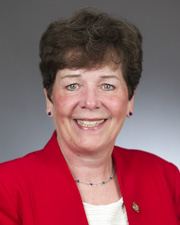High cancer rates among firefighters need answer to the question 'why?'
Steve Shapira was serving as a St. Paul fire captain when he was diagnosed with non-Hodgkin lymphoma in 2012. The veteran firefighter didn’t smoke and didn’t have a family history of the disease that eventually forced him to retire, but his profession put him at risk, he told the House Health and Human Services Reform Committee Tuesday.
Studies indicate firefighters are more than twice as likely to be diagnosed with cancer as the general population, Rep. Peggy Bennett (R-Albert Lea) said. She sponsors HF1295, which would track incidences of firefighters with cancer and allow researchers to gauge the effectiveness of prevention efforts, and possibly develop ways to protect firefighters in the future, Bennett said.
The bill was approved as amended and referred to the House Health and Human Services Finance Committee. The companion, SF1132, sponsored by Sen. Jim Abeler (R-Anoka), awaits action in the Senate Health and Human Services Finance and Policy Committee.
The Department of Health’s Cancer Surveillance System collects a range of demographic information on cancer patients. HF1295 would have the department collect voluntary information about whether those patients were firefighters as well, Bennett said.
Information collected would not only include basic demographic information, but also whether the firefighters worked full-time or as volunteers, what other jobs they held, if they engaged in any high-risk behaviors like smoking, how many fire incidents they attended, what types of fires they were, what sort of cancer they contracted and when.
The system would also track which fire departments the firefighters with cancer worked at, allowing researchers to examine what kind of cancer prevention initiatives were in place at the time and gauge their effectiveness.
Bennett said current strategies to reduce the number of firefighters with cancer include awareness and screening initiatives as well as efforts to better decontaminate turnout gear and equipment after calls, but there needs to be a way to conduct focused research.
Related Articles
Search Session Daily
Advanced Search OptionsPriority Dailies
Ways and Means Committee OKs proposed $512 million supplemental budget on party-line vote
By Mike Cook Meeting more needs or fiscal irresponsibility is one way to sum up the differences among the two parties on a supplemental spending package a year after a $72 billion state budg...
Meeting more needs or fiscal irresponsibility is one way to sum up the differences among the two parties on a supplemental spending package a year after a $72 billion state budg...
Minnesota’s projected budget surplus balloons to $3.7 billion, but fiscal pressure still looms
By Rob Hubbard Just as Minnesota has experienced a warmer winter than usual, so has the state’s budget outlook warmed over the past few months.
On Thursday, Minnesota Management and Budget...
Just as Minnesota has experienced a warmer winter than usual, so has the state’s budget outlook warmed over the past few months.
On Thursday, Minnesota Management and Budget...
